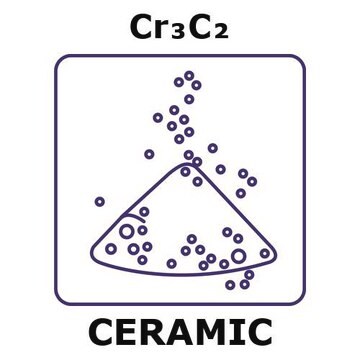All Photos(3)
About This Item
Linear Formula:
Fe
CAS Number:
Molecular Weight:
55.85
EC Number:
MDL number:
UNSPSC Code:
12352300
PubChem Substance ID:
NACRES:
NA.22
Recommended Products
Quality Level
Assay
97%
form
powder
reaction suitability
core: iron
reagent type: catalyst
resistivity
9.71 μΩ-cm
particle size
−325 mesh
bp
2750 °C (lit.)
mp
1535 °C (lit.)
density
7.86 g/mL at 25 °C (lit.)
SMILES string
[Fe]
InChI
1S/Fe
InChI key
XEEYBQQBJWHFJM-UHFFFAOYSA-N
Related Categories
Application
Iron is generally used as a catalyst for wide variety of organic transformations. It has been used for the synthesis of magnetic polydimethylsiloxane (PDMS) for automated microcontact printing of biomolecules.
Iron can also be used:
Iron can also be used:
- For the removal of arsenate from water.
- To synthesize Fe(III) iodide catalyst for thioglycosylation of peracetylated saccharides.
- As a catalyst for the graphitization for microscale radiocarbon analysis of small samples.
- For the removal of nitroaromatic pesticides by reduction.
Physical form
Hydrogen reduced
Signal Word
Warning
Hazard Statements
Precautionary Statements
Hazard Classifications
Flam. Sol. 2 - Self-heat. 2
Storage Class Code
4.2 - Pyrophoric and self-heating hazardous materials
WGK
nwg
Flash Point(F)
69.8 °F
Flash Point(C)
21 °C
Certificates of Analysis (COA)
Search for Certificates of Analysis (COA) by entering the products Lot/Batch Number. Lot and Batch Numbers can be found on a product’s label following the words ‘Lot’ or ‘Batch’.
Already Own This Product?
Find documentation for the products that you have recently purchased in the Document Library.
Customers Also Viewed
Technical progress in AMS microscale radiocarbon analysis.
Uchida M, et al.
Nucl. Instrum. Methods Phys. Res. Sect. B, 223(46), 313-317 (2004)
Diastereoselective thioglycosylation of peracetylated glycosides catalyzed by in situ generated iron (III) iodide from elemental iodine and iron.
Weng SS
Tetrahedron Letters, 50(46), 6414-6417 (2009)
Fabrication of biomolecule microarrays for cell immobilization using automated microcontact printing.
Cell-Based Microarrays, 83-95 (2018)
Arsenate removal by zero valent iron: batch and column tests.
Biterna M, et al.
Journal of Hazardous Materials, 149(3), 548-552 (2007)
Reduction of nitroaromatic pesticides with zero-valent iron.
Keum Y S and Li Q X
Chemosphere, 54(3), 255-263 (2004)
Our team of scientists has experience in all areas of research including Life Science, Material Science, Chemical Synthesis, Chromatography, Analytical and many others.
Contact Technical Service




